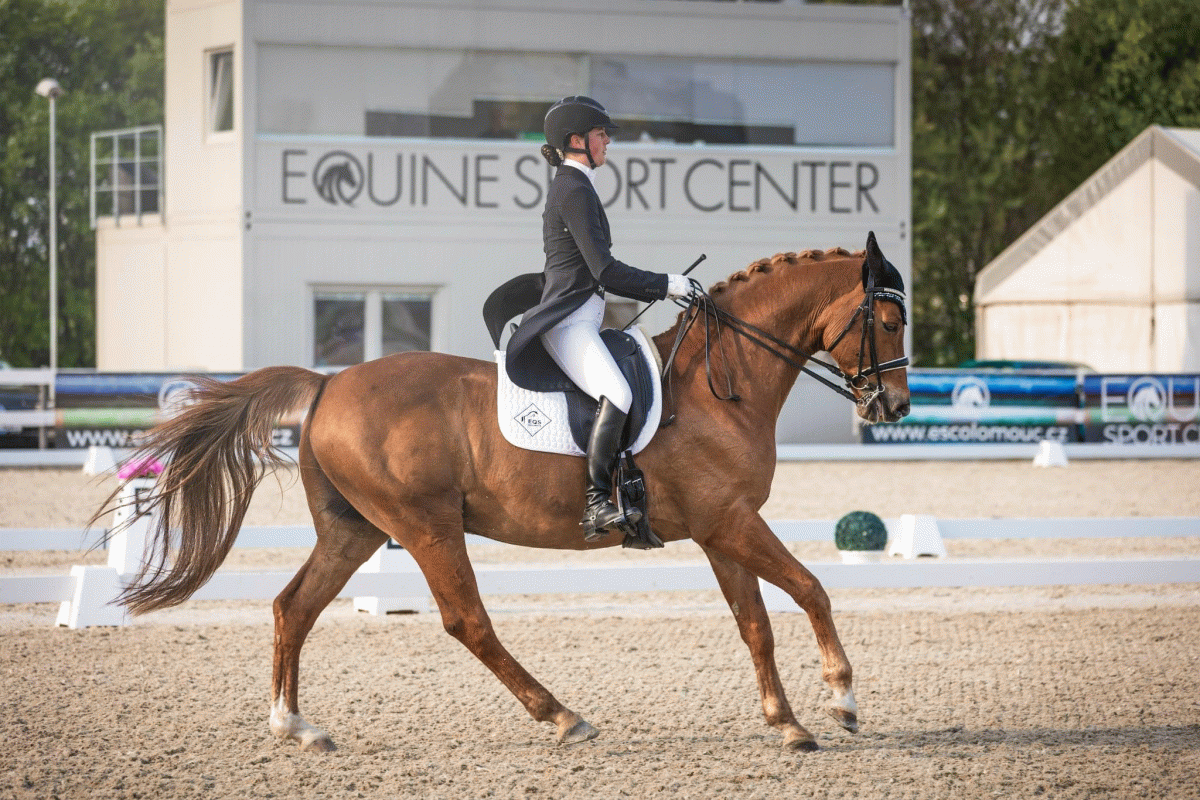
Článek v češtině si můžete přečíst ZDE.
Barbora Zourková is a dressage rider and a fresh graduate of the Horse Breeding and Agrotourism course at Mendel University. Her diploma thesis has combined dressage with research based on data from the EQUIMO tracker, and we are bringing you an interview where she explains what she has focused on and what results she has reached.
Firstly, can you introduce your equestrian background and the thesis it has led to?
I ride dressage up to the Intermediate level, together with my own gelding Fénix. After I had done basic riding exams, my parents bought him when I was thirteen, and he was four, so we’ve learned everything together. Fénix had already done a few eventing shows, so he knew at least something at the time. We have been together for eleven years, done several Czech championships and two international shows.
The whole title of my thesis is Comparison of the Level and Balance of the Listed National and International Dressage Tests Using the EQUIMO Tracking Device. I have agreed on its topic with my leading teacher, Ing. Eva Sobotková, Ph.D. I wanted a follow-up to my bachelor’s thesis, which dealt with a dressage horse’s training. To connect dressage with EQUIMO seemed like a great idea as there are no studies on such a topic.
What was your research about, and how did you perform it?
The content of my research was to ride chosen FEI dressage tests from the Intro to Intermediate level and compare them. I have chosen twelve tests most commonly seen at shows. I performed all the measuring only with Fénix, so it took a lot of time. Each test had „only“ three repetitions, and I performed thirty-six measuring sessions in total. All the tests were ridden in our stable, where I built a dressage arena to simulate the show environment as much as possible. I started measuring before entering the arena and stopped after the final halt. I tracked the total time, time of walk, trot, canter, balance to the left and right in all gaits, total distance covered in all the gaits, and burnt calories.
One of the aims of this thesis was also to research the usability of EQUIMO for dressage and suggest possible adjustments for dressage riders.
Have you encountered any issues?
One of the above-mentioned limitations was a small number of repetitions. I dare to say that the final data was exact but it would, of course, be better to have more data for better comparison.
The aim was originally to combine EQUIMO with a heart rate tracker by Polar. Unfortunately, Polar wasn’t quite reliable, so I abandoned this plan after speaking with my leading teacher. It’s a shame my thesis had been performed before EQUIMO’s Heart Rate Set was introduced to the market. I believe that combining these tracking devices would take my thesis to another level, and I’d be interested in such data.
Last but not least, I’d like to point out that EQUIMO isn’t capable of distinguishing different dressage figures, which is understandable as it isn’t primarily designated for dressage riders. This leads me to believe that the data from tests above the Medium level might be slightly misrepresented, for example when it comes to burnt calories. In logical consequence, if I do a half-pass but the tracker measures it just as a diagonal movement, there could be some differences.
By tracking heart rate, we could (at least partly) distinguish more difficult figures. There have been some studies using sensors attached to horses‘ limbs. I am really excited to see what potential cooperation could bring were I to try and connect EQUIMO with dressage riding. :)
What results did your research bring?
My study has found a correlation between the time of the tests, their distance, and burnt calories. Easy levels, such as Prelim and Novice, were pretty similar. Then the more difficult tests of Advanced Medium, PSG, and Intermediate also corresponded. However, I have to mention the difference between the figures in these tests, so it isn’t possible to compare the difficulty of tests based only on the above-mentioned data.
There was a major inequality in walk (considering movement to left and right), much larger than in trot. We can generally say that there are considerably fewer walk parts in tests up to Elementary. Long canter passages come in tests of PSG and Intermediate level, which is logical, considering the more difficult figures these tests contain.
Had you worked with EQUIMO before, or was this your very first experience?
I learned to work with EQUIMO only owing to my thesis. The tracker had interested me before, and I am very thankful to the company for allowing me to try it.
How was your experience of working with the tracker?
I was very positively surprised. The tracker itself didn’t take up any space during sessions, and the app is user-friendly, easy to use, and lucid. All the data was uploaded quite quickly, and I could view them after several months, which made the processing of the research easier.
Have you applied the study outcome to your own life with horses?
Definitely. I have been riding with EQUIMO until now, both in an arena and outside. I had always tried to have balanced sessions, and I have realized they are not as completely balanced as I would wish them to be, which has changed now with the tracker. I was also surprised to see how big part of a training session I spent walking.
My study has led me to realize how unevenly some of the tests are constructed, and I have also been surprised by paradoxical differences between distances and time of tests on various levels. I have also become aware of the importance of canter fitness, as higher levels really require longer, and harder canter passages compared to the trot ones.